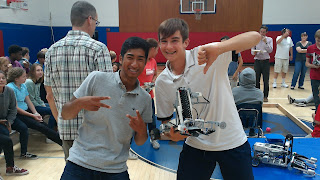This year, the Advanced Engineering I students took on a challenge from our very own fitness guru, Scott Mitchell. Mr. Mitchell, who teaches middle school P.E. and runs our outdoor education program, is passionate about his craft. He wants students to understand the human body, in terms of both structure and motion. Mr. Mitchell has long used tensegrity structures as an analogy to help students visualize these principles.
What's a tensegrity structure, you ask? While a formal definition is somewhat elusive, you know it when you see it. Popularized by the architect Buckmister Fuller and his student, sculptor Kenneth Snelson, these structures feature "compression members floating in a sea of tension." Still confused?
Here's an animated GIF from Wikipedia's page:
The engineering class began with some small models, using elastic bands for the tension elements and wooden dowels for the compression struts.
 |
| Victor with the most simple of all tensegrity structures: three sticks not touching |
 |
| Victor and Todd with a six-member icosahedron |
 |
| Josh finds a new use for the 12-stick version |
As simple as these look, they take a great deal of effort to plan and assemble. But this was not the end goal; our class aimed to build a giant version of the icosahedron, with compression members 8 feet long!
Attempt 1:
A lot of knots tied to create 24 rope members. Attached lag bolts to 20 lb beams. Got it together and realized that everything was way too loose. Too much sag. Took it apart.
 |
| Alena carefully loops the non-slip knot over the bolt |
 |
| Ben gets those bolts secured |
 |
| Inital success and exuberance, but everything is far too loose |
Attempt 2:
All rope connections shortened by 5 inches to tighten things up. Unfortunate result: humanly impossible to pull together. Mr. Mitchell attempted to complete the final connections under great duress. Failure, bent bolts, and an abandoned attempt.
Attempt 3:
Straightened out bolts. Loosened all rope lengths by 2 inches. Realized that we can do this the easy way, working with the structure and not against it. Beams held in different orientation. Pulled it all together, but some bolts bent again. Much tighter, much easier, good result!
 |
| Colby and Todd compare the 8-foot version to the 12-inch! |
Attempt 4:
Practice makes perfect! Rechecked all ropes, and found a few that were too long. Replaced all bolts with thicker ones twice as strong in bending. Worked in new orientation and got it together in under 10 minutes! (Compare this video to the last.)
 |
| Mr. Meadth tests it out before anyone else--in the name of safety, of course! |
 |
| Todd climbs inside once everything is approved |
 |
| Eva's turn! |
Here's another interesting observation: in the interest of safety, we strapped a force gauge to the ropes, and measured 150 lb of tension. (These ropes are rated up to 300 lb, so no problem!) But when Mr. Meadth climbed up on top, weighing about 155 lb himself, the rope tension only increased to 190 lb. How fascinating that 155 lb of live weight does not increase the rope tensions by that amount.
In fact, three people at one time were able to climb up on the structure (totalling more than 300 lb), but the max load reading never exceeded 250 lb, with no evidence of any structural problems.
It's stable, folks! It beautifully and naturally distributes extra load all around to find equilibrium, much like the human body. Even as it moves, it naturally corrects, distorts, and stabilizes. Watch Todd roll a few feet in the following video.
Needless to say, Mr. Mitchell was delighted with the outcome, and brought his middle school P.E. students over to see, touch, and feel its dynamic responses. He taught them that the wooden beams are analagous to our bones, and the tensioned ropes are like our ligaments and tendons and muscles. Inspired by the work of Anatomy Trains, it's easy to see what happens when our bodies are injured or out of alignment.
Great work, students! Keep on dreaming, designing, calculating, and serving others! Please share this article freely with friends and family.
 |
| A good day's work! |











































